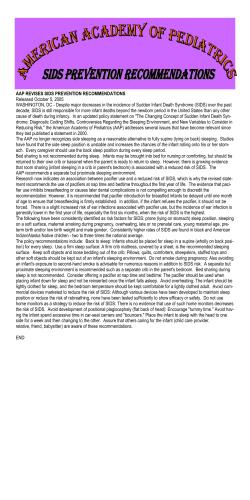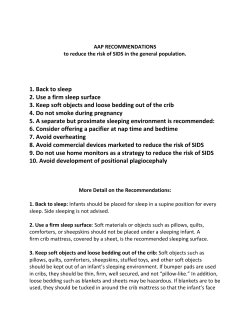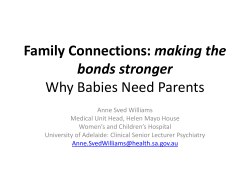
HOSPITAL SAFE SLEEP POLICY TEMPLATE
HOSPITAL SAFE SLEEP POLICY TEMPLATE INTRODUCTION. First Candle/National SIDS Alliance, in conjunction with the Eunice Kennedy Shriver National Institute on Child Health and Development (NICHD) are seeking national and local organizations to partner with as we promote our hospital infant safe sleep policy template. This template is designed as a resource for hospitals, to be used as they develop or update their infant safe sleep policy and protocol. It reflects the most current evidence-based research and 2011 AAP guidelines. Included are recommendations for NICU and well-baby nurseries, as well as teaching points for staff and patient education. References are cited at the end of this document. We understand most hospitals have their own specific standards and format for their written policies. It is not our intent to dictate how a hospital will develop and implement such a policy; this document was written to offer a template, technical assistance and support in the process. Our goal is for every birthing hospital to have an infant safe sleep policy. We are excited to work with hospitals across the country to bring this goal to fruition. We hope you will join our efforts. In the belief that every baby deserves a first birthday and beyond, Barb Himes Director of Education and Training [email protected] HOSPITAL SAFE SLEEP POLICY (Evidence-Based) GOALS. 1. To provide a uniform model hospital policy for healthcare providers in the newborn, Level II/ III/IV nurseries and pediatric settings 2. To ensure that all recommendations are modeled and understood by caregivers/parents with consistent instructions given prior to discharge RATIONALE. A major decrease in the incidence of sudden infant death syndrome (SIDS) occurred when the American Academy of Pediatrics (AAP) released its initial recommendation in 1992 that infants be placed in a non-prone position for sleep. The incidence of SIDS has leveled off in recent years, while the incidence of other causes of sudden unexpected infant death that occur during sleep (including suffocation, asphyxia and entrapment) has increased. The AAP has expanded its recommendations to include a safe sleep environment, which reduces the risk of all sleep-related infant deaths, including SIDS. Research has shown that SIDS is not caused by vomiting, choking and immunizations. DEFINITIONS. Bed Sharing The practice of a parent, sibling or other individual sleeping together with the infant on a shared sleep surface, i.e. a bed, sofa, recliner, etc. (not recommended). Co-sleeper A three-sided crib that attaches to the parent’s bed. Safety standards have not yet been established for these devices. Health Care Provider Physicians, nurse practitioners, certified nurse midwives, nurses, lactation consultants Plagiocephaly The appearance of a persistent flat spot on an infant’s head. Room Sharing Infant sleeping in a crib or other separate and safe surface in the same room as the parent/caregiver (recommended). SIDS Sudden Infant Death Syndrome - the sudden death of an infant under 1 year of age, which remains unexplained after a thorough case investigation, including performance of a complete autopsy, examination of the death scene, and review of the clinical histories. Tummy Time Infants are placed on tummy when they are awake and someone is supervising. Tummy time helps strengthen the infant’s head, neck and shoulder muscles, and helps to prevent flat spots on the head. POLICY AND PROCEDURE. Sleep Position. • All infants > 32weeks will be placed on their back to sleep during every nap and nighttime for the first year unless otherwise ordered by the physician. Side sleeping is no longer advised and should be used only if there is a physician order. • The flat supine sleeping position does not increase the risk of choking and aspiration in infants, even those with gastroesophageal reflux. • Level II/III/IV nurseries will start to transition to back sleeping as soon as the infant is medically stable, well in advance of discharge. Teaching Points: • Teach parents to place infants on their backs to sleep for every sleep. Have parents communicate this “back to sleep” message with everyone who cares for their infant. • Use visual aids to show parents that the supine position does not increase the risk of choking and aspiration. In fact, babies may actually clear secretions better when placed on their backs. The figures above show the orientation of the trachea to the esophagus in the back sleeping (Figure 3) and stomach sleeping (Figure 4) positions. When a baby is in the back sleeping position, the trachea lies on top of the esophagus. Anything regurgitated or refluxed from the esophagus must work against gravity to be aspirated into the trachea. Conversely, when a baby is in the stomach sleeping position, anything regurgitated or refluxed will pool at the opening of the trachea, making it easier for the baby to aspirate. • • • The risk of SIDS is 7 to 8 times higher among infants who normally sleep on their backs when placed on their stomachs to sleep. Side lying is an unstable sleeping position because the infant can more easily roll to the prone position. Side positioning is not recommended. Once an infant can roll from supine to prone and from prone to supine, the infant can be allowed to remain in the sleep position that he or she assumes. Sleep Surface. • Mattresses should be firm and maintain their shape. There should be no gaps between the mattress and the side of the crib, bassinet, portable crib or play yard. • Only mattresses and tightly-fitted sheets designed for the specific type of product should be used. Teaching Point: • Pillows or cushions should not be substituted for mattresses or in addition to a mattress. Couches, adult mattresses, futons, etc. are not considered a firm sleeping surface. • Soft materials or objects such as pillows, quilts, comforters or sheepskins, even if covered by a sheet, should not be placed under a sleeping infant. • If an additional waterproof pad is used, it should be thin and tightly fitted. • Sitting devices, such as car safety seats, strollers, swings, infant carriers and infant slings are not recommended for routine sleep in the hospital or at home. Bedding. • Keep all soft objects and loose bedding out of the crib Teaching Point: • No bumper pads, stuffed toys or any other objects in the crib. “NOTHING BUT BABY.” • Appropriately sized sleep sacks/blanket sleepers are optimal; avoid blankets and other loose bedding. Smoking, Drugs and Alcohol. • Do not expose babies to secondhand smoke. • Second to sleep position, smoke exposure is the largest contributing risk factor for SIDS. • Avoid alcohol and illicit drug use. Teaching Point: • Clothing exposed to secondhand smoke should be changed, or a cover gown provided, prior to handling infants. • Wash hands after smoking and before touching infant. • Encourage families to set strict rules for smoke-free homes and cars to eliminate secondhand smoke. • Anyone who is sleep deprived or using alcohol or medications causing diminished responsiveness in combination with bed sharing also places an infant at high risk. • Share smoking cessation resources in your institution or community. Sleeping Environment. • Room sharing without bed sharing is recommended. • Keep the infant’s sleep area close to, but separate from, where parents sleep. Teaching Points: • Bed sharing with anyone, including parents, other children and particularly multiples is not safe. Pets also pose a threat to sleeping infants. • Infants may be brought into bed for feeding or comforting but should be returned to their own bed when the parent is ready to return to sleep. • The infant’s crib, portable crib, play yard or bassinet should be placed in the parent’s room, close to their bed, making it more convenient for feeding and contact. • Infants should not be fed/held on a couch, armchair or in bed when there is a high risk that the parent might fall asleep. • Sleeping on a couch, recliner or armchair with an infant is not safe. Pacifier Use. • Pacifier use is recommended throughout the first year of life when placing infant down to sleep unless contraindicated or refused by parents. Teaching Points: • For breastfed infants, avoid pacifier use until breastfeeding is firmly established (approx. 1 month). • It is not necessary to reinsert a pacifier once the infant falls asleep. • Do not force an infant to take a pacifier. • Educate parents that pacifiers should not be coated in any sweet solution, hung around the infant’s neck or attached to clothing while sleeping. Overheating/Over-bundling. • Avoid overheating or over-bundling infant. • Infants should be dressed appropriately for the environment, with no more than one additional layer than an adult would wear to be comfortable. Teaching Points: • Appropriately sized sleep sacks /blanket sleepers are optimal; avoid blankets and other loose bedding. • Suggest layering clothing as a secondary choice. • Acknowledge cultural beliefs and how it affects safe sleeping. • If swaddling is needed for comfort or thermoregulation, swaddle below the axilla. • Kangaroo Care or skin-to- skin is another method of thermoregulation but should be used only when mother is awake. • Teach parents to evaluate infants for signs of overheating, such as sweating or the chest feeling hot to touch. • Do not cover the infant’s face or head. NICU/Special Care (Level II/ III/IV). • Infants should be placed in the supine position for sleep as soon as medically stable and significantly before anticipated discharge (by 32 weeks postmenstrual age). Teaching Point: • Endorse safe-sleeping guidelines with parents from the time of admission. Positioning Aids/Commercial Devices. • Staff in Level II/ III/IV nurseries should model and implement all SIDS risk reduction recommendations as soon as the infant is clinically stable and significantly before anticipated discharge. Remove developmental aids as appropriate. • Avoid commercial devices marketed to reduce the risk of SIDS—these include wedges, positioners, special mattresses, and special sleep surfaces. Teaching Points: • Inform parents to avoid commercial devices marketed to reduce the risk of SIDS, plagiocephaly and acid reflux (products include wedges, positioning aids, rolled blankets). • There is no evidence that these devices reduce the risk of SIDS or suffocation, or that they are safe. Monitoring Devices. • Infants with cardio/respiratory instability may require a cardiopulmonary monitor. • No monitoring device can identify, predict or prevent SIDS. Teaching Point: • Educate parents and caregivers that monitors are only machines and are not substitutes for direct observation. Tummy Time. • Supervised, awake tummy time is recommended on a daily basis, beginning as early as possible, to promote motor development, facilitate development of the upper body muscles, and minimize the risk of positional plagiocephaly. Teaching Points: • Avoid plagiocephaly by: limiting time in car seats, carriers, bouncers, and other devices. encouraging “cuddle time” (bonding) by holding infant. changing the infant’s orientation in the bed. Back to Sleep. • Educate parents on the importance of following all of the AAP Policy Statement Recommendations for Safe Sleep well before discharge. • Document that safe sleep education was provided. Teaching Point: • Request that parents share safe sleep message with EVERYONE caring for their infant (grandparents, babysitters, child care providers, etc). • Readmission of infants under 1 year of age is an excellent opportunity to ask where the infant normally sleeps and to re-enforce AAP safe sleep recommendations. Breastfeeding. • Breastfeeding is recommended. • Breastfeeding is associated with a reduced risk of SIDS. If possible, mothers should exclusively breastfeed or feed with expressed human milk (i.e., not offer any formula or other non-human milk-based supplements) for six months, in alignment with AAP recommendations. Teaching Point: • The protective effect of breastfeeding increases with exclusivity. However, any breast milk feeding has been shown to be more protective against SIDS than formula feeding. Immunization. • Infants should be immunized in accordance with recommendations of the AAP and the Centers for Disease Control and Prevention. Teaching Points: • There is no evidence that there is a causal relationship between immunizations and SIDS. • Recent evidence suggests that immunization might have a protective effect against SIDS. -For guidelines on current crib safety standards, visit www.jpma.org -For information on swaddling, visit http://pediatrics.aappublications.org/cgi/content/full/120/4/e1097 -To download a “Safe Nursery” booklet, go to http://www.cpsc.gov/cpscpub/pubs/202.pdf REFERENCES. American Academy of Pediatrics, Task Force on Sudden Infant Death Syndrome. (2011). SIDS and Other Sleep-Related Infant Deaths: Expansion of Recommendations for a Safe Infant Sleeping Environment. Pediatrics, 128(5), 1030-1039. Baddock SA, Galland BC, Bolton DP, Williams SM and Taylor BJ. (2012). Hypoxic and Hypercapnic Events in Young Infants During Bed-sharing. Pediatrics,130, 237-244 Deaths and Injuries Attributed to Infant Crib Bumper Pads. Journal of Pediatrics. Volume 151, Issue 3. September 2007. Fu LY, Colson ER, Corwin MJ and Moon RY. (2008). Infant Sleep Location: Associated Maternal and Infant Characteristics with Sudden Infant Death Syndrome Prevention Recommendations. Journal of Pediatrics, 153, 503-508 Helsley L, McDonald JV and Stewart VT. (2010) Addressing In-Hospital Falls of Newborn Infants. The Joint Commission Journal on Quality and Patient Safety, 36 (7),327-333 Images and source: Continuing Education Program on SIDS Risk Reduction: Curriculum for Nurses. National Institutes of Health, 2006. Available at http://www.nichd.nih.gov/publications/pubs/upload/Cont_Ed_Prog_Nurses_SIDS.pdf Merenstein G and Gardner S (2011) Handbook of Neonatal Intensive Care (7th ed). Maryland Heights MO: CV Mosby/Elsevier Monson SA, Henry E, Lambert DK, Schmutz N and Christensen RD. (2008) In-Hospital Falls of Newborn Infants: Data From a Multihospital Health Care System. Pediatrics, 122(2), e277-e280 Moon RY, Oden RP, Joyner BL and Ajao TI. (2010) Qualitative Analysis of Beliefs and Perceptions about Sudden Infant Death Syndrome in African American Mothers: Implications for Safe Sleep Recommendations. Journal of Pediatrics, 157, 92-7 National Association of Neonatal Nurses position statement on co-bedding of twins and higher-order multiples. Retrieved 2/4/13 from http://www.nann.org/uploads/files/Cobedding_of_Twins_or_Higher-Order_Multiples_2011.pdf Schnitzer PG, Covington TM and Dykstra HK. (2012) Sudden Unexpected Infant Deaths: Sleep Environment and Circumstances. American Journal of Public Health, 102(6), 1204-1212 Shaefer SJ, Herman SE, Frank SJ, Adkins M and Terhaar M. Translating Infant Safe Sleep Evidence into Nursing Practice (2010) Journal of Obstetric, Gynecologic and Neonatal Nursing, 39, 618-626 Shapiro-Mendoza CK, Kimball M, Tomashek KM, Anderson RN and Blanding S. (2009), US Infant Mortality Trends Attributable to Accidental Suffocation in Bed from 1984-2004: Are Rates Increasing?, Pediatrics, 123,533-539 Trachtenberg FL, Haas EA, Kinney HC, Stanley C and Krous HF. (2012) Risk Factor Changes for Sudden Infant Death Syndrome After Initiation of Back-to-Sleep Campaign. Pediatrics, 129,630-638 Vandenplas Y, Rudolph CD, Di Lorenzo C, et al. Pediatric gastroesophageal reflux clinical practice guidelines: joint recommendations of the North American Society for Pediatric Gastroenterology, Hepatology, and Nutrition (NASPHGAN). J Pediatr Gastroenterol Nutr. 2009;49(4):498-547 Vennemann MM, Hense HW, Bajanowski T. Blair PS, Complojer C, Moon RY, and Kiechl-Kohlendorfer U. (2012) Bed Sharing and the Risk of Sudden Infant Death Syndrome: Can We Resolve the Debate? Journal of Pediatrics, 160, 44-48 Verklan MT and Walden M (2010).Core Curriculum of Neonatal Intensive Care Nursing (4th ed). Philadelphia PA: Saunders. Developed 2009/Revised 2010/2012/2013
© Copyright 2026










